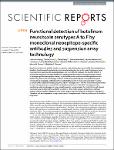Functional detection of botulinum neurotoxin serotypes A to F by monoclonal neoepitope-specific antibodies and suspension array technology
von Berg, Laura
Stern, Daniel
Pauly, Diana
Mahrhold, Stefan
Weisemann, Jasmin
Jentsch, Lisa
Hansbauer, Eva-Maria
Müller, Christian
Avondet, Marc A.
Rummel, Andreas
Dorner, Martin B.
Dorner, Brigitte G.
Botulinum neurotoxins (BoNTs) are the most potent toxins known and cause the life threatening disease botulism. Sensitive and broad detection is extremely challenging due to the toxins’ high potency and molecular heterogeneity with several serotypes and more than 40 subtypes. The toxicity of BoNT is mediated by enzymatic cleavage of different synaptic proteins involved in neurotransmitter release at serotype-specific cleavage sites. Hence, active BoNTs can be monitored and distinguished in vitro by detecting their substrate cleavage products. In this work, we developed a comprehensive panel of monoclonal neoepitope antibodies (Neo-mAbs) highly specific for the newly generated N- and/or C-termini of the substrate cleavage products of BoNT serotypes A to F. The Neo-mAbs were implemented in a set of three enzymatic assays for the simultaneous detection of two BoNT serotypes each by monitoring substrate cleavage on colour-coded magnetic Luminex-beads. For the first time, all relevant serotypes could be detected in parallel by a routine in vitro activity assay in spiked serum and food samples yielding excellent detection limits in the range of the mouse bioassay or better (0.3–80 pg/mL). Therefore, this work represents a major step towards the replacement of the mouse bioassay for botulism diagnostics.

